Bell's review gives some useful background:
While it was not altogether uncommon for teenage peasant girls in the late Middle Ages to have religious visions, it was rather more unusual for them to advise kings and lead armies into battle. From the moment the teenage Joan and her visions appeared at the French court in 1429, she attracted enormous attention, which only increased as she helped guide French forces to a string of victories over the English. This was followed by King Charles VII’s formal coronation — a decisive moment in the Hundred Years War. And then, in a stroke of excellent luck for her biographers (if not for Joan herself), she fell into the hands of the single institution that compiled more complete records of intimate lives than any in history up to that point: the Inquisition. In an effort to prove Joan guilty of heresy, the inquisitors interrogated her, and numerous witnesses, in remarkable detail about her actions, her visions, and her beliefs.A full century after Joan's execution another maiden visionary was hung for treason. Although her life story is very different from Joan's, it was given a similar extensive record in contemporary court documents. She was Elizabeth Barton, called the Holy Maid, Mad Maid, or simply Nun of Kent. Although not nearly so popular as Joan, there are many accounts of Barton's exploits and it's interesting that, for all this extensive discussion,3 there's still some controversy about her.
The controversy concerns whether she was a true or false visionary. The evidence all points to the latter. Those who dispute it do not offer contrary evidence, but say existing records are biased. Here's the basic outline: As a young serving girl she had suffered hallucinations on recovering from a serious illness. She worked as one of the lowest servants in an archbishop's establishment and thus was constantly in contact with monks, priests, and other religious. Some of these men proved to be opportunistic and unscrupulous. They encouraged her to manufacture visions that served their own private interests and the interest of the Catholic Church in England.
The public record includes a copy of a statement Barton made on the scaffold as she was about to be hung for treason. It was too late to beg clemency and we can thus expect what she said to have been the truth as she saw it. Here's Gilbert Burnet's account of what she said:
Soon after that, on the 20th of April, the Nun, and [her accused accomplices] Docking, Master, Deering, Risby, and Gold (Rich is not named, being perhaps either dead or pardoned) were brought to Tyburn. The Nun spake these words: — "Hither I am come to die; and I have not been only the cause of mine own death, which most justly I have deserved, but also I am the cause of the death of all those persons, which at this time here suffer. And yet, to say the truth, I am not so much to be blamed, considering that it was well known to these learned men that I was a poor wench, without learning, and therefore they might easily have perceived that the things that were done by me could not proceed in no such sort; but their capacities and learning could right well judge, from whence they proceeded, and that they were altogether feigned; but because the thing that I feigned was profitable that the things that were done by me could not proceed in no such sort; but their capacities and learning could right well judge from whence they proceeded, and that they were altogether feigned; but because the thing which I feigned was profitable to them, therefore they much praised me, and bore me in hand, that it was the Holy Ghost, and not I, that did them; and then I, being puffed up with their praises, fell into a certain pride and foolish fantasy with myself, and thought I might feign what I would, which thing hath brought me to this case: and for other which now I cry God and the King's Highness most heartily mercy, and desire you all, good people, to pray to God to have mercy on me, and on all them that here suffer with me." 4The difficulty with this is that there is no independent verification; the person who disseminated it may simply have made it up. Still, the evidence that exists all points one way and those who deny it have little to offer.
-- The history of the reformation of the Church of England, Volume 1 by Gilbert Burnet (Scott, Webster, & Geary, 1889)
In the novel Wolf Hall, about which I recently wrote, Hilary Martel shows her protagonist, Thomas Cromwell, to see Barton as an unfortunate whose delusions priests market to the credulous. He recalls hearing of her speaking in alien voices, her visions of the principal saints, and her reputation as a seer: telling people whether their dead relatives are in Heaven or Hell. He's heard that following an illness she began to suffer "spasms, torsions, and trances." She was accepted into a convent at Canterbury and the money then came rolling in. "There are cures," he says. "The lame walk, the blind see. Candles light by themselves. The pilgrims are thick upon the roads. Why do I feel I have heard this story before? She has a flock of monks and priests about her, who direct the people's eyes heavenward while picking their pockets."5
Barton's popularity brought wealth to her handlers but they wanted more; soon her voices began to tell her that King Henry VIII would die and go to Hell if he continued his quest to put aside Queen Katharine and marry Anne Bolene. Wikipedia puts it thus: "Around 1532 she began prophesying that if the King would remarry he would die shortly thereafter. (He would in fact live for 15 years.) Remarkably, Barton went unpunished for nearly a year, in large part because she appears to have been more popular than the King in many quarters.6 In fact, Barton was tried for treason only after supporters of the King had spread rumours that Barton was engaged in sexual relationships with her priests. Others asserted that Barton suffered from mental illness. With her reputation damaged, in 1533 the crown arrested her and forced Barton to make either a real confession or a fabricated one."7
A breakaway Anglican organization, the Anglican Catholic Church, considers Barton to be a holy martyr and one of its member churches has put up an icon to her memory:
-------------
Additional sources on Joan of Arc (see note 3 for sources on Elizabeth Barton):
- Joan of Arc
- Trial of Joan of Arc
- Joan of Arc (1412-1431) an online university research project
- Joan of Arc section of the Philosophical Dictionary of Voltaire
- Selected and Translated by H.I. Woolf New York: Knopf, 1924
- Medieval Sourcebook: The Trial of Joan of Arc
- JOAN of ARC
- OF HER TIME AND PLACE Capter One, Joan of Arc By MARY GORDON A Lipper/Viking Book Read the Review
Notes:
1 A search of WorldCat turns up 10,417 works for the phrase "Joan of Arc". WorldCat contains 5,065 books with Joan of Arc as main subject and it contains 2,681 with Joan of Arc as title. Google has more than a couple million hits for the phrase.
2 The wikipedia article on Joan says the only portrait for which she is known to have sat has not survived. It gives this minature of c. 1485 as the earliest artist's interpretation.

There's a wikipedia article that discusses cultural depictions of Joan of Arc.
Here's a smattering of images taken from Google:

by an unknown artist, 20th century, found on theage.com
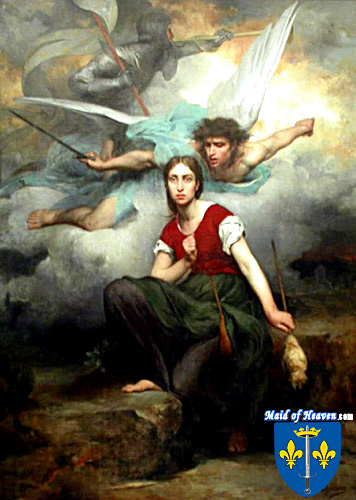
by Eugene Thirion in 1876 from maidofheaven.com

an early 19th c. engraving out of Le Brun de Charmette’s L’Orléanide poème national from columiba.edu
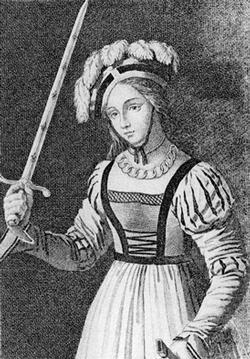
artist and date unknown, found on nndb.com
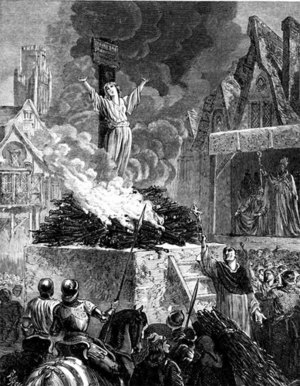
artist and date unknown, found on sott.net

artist and date unknown, found on nndb.com from the Isabell Dell collection at Pace University
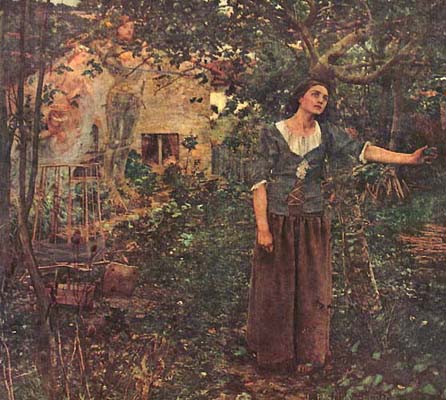
an Impressionist work made in 1880 by Bastien-Lepage found on stjoan-center.com
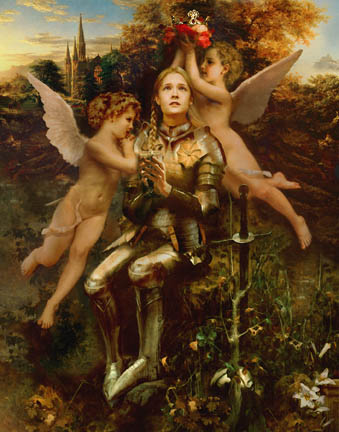
by Howard David Johnson found on thejohnsongalleries.com

from a photoengraving by Mme. Zoe-Laure de Chatillon about 1880, found on about.com
.jpg)
by Jules-Eugène Lenepveu abuot 1890 found on powellhistory.com

at the Coronation of Charles VII
by Jean-Auguste-Dominique Ingres found on powellhistory.com

by Gaston Bussiere found on powellhistory.com
(It's not surprising these images generally show Joan looking upward. Depictions of women saints usually do. But, for me anyway, the convention conceals the feisty spirit that she undoubtedly possessed. Compare the upward glancing ones with those others shown above where she's look at or below the horizon -- or directly at the viewer.)
3 A search of WorldCat gives only a couple dozen works about the "Holy Maid of Kent" or variant sobriquets. Here are some web sources:
- Elizabeth Barton in wikipedia
- Elizabeth Barton, an article on the website called tudorplace.com
- 1911 Encyclopædia Britannica/Barton, Elizabeth
- Elizabeth Barton, an article in the New Advent Encyclopedia
- Elizabeth Barton in encyclopedia.com
- The history of the reformation of the Church of England, Volume 1 by Gilbert Burnet (Scott, Webster, & Geary, 1889)
- The spiritual magazine, Volume 4 (F. Pitman., 1866)
4 Compare a confession that Joan made and then retracted. First the confession:
Jeanne's AbjurationAnd the retraction:
"All those who have erred and been at fault in the Christian faith and have by God's grace returned to the light of truth and unity of Our Holy Mother Church, should vigilantly prevent the Enemy of Hell from driving them back and causing their relapse into error and damnation. Therefore, I, Jeanne, commonly called The Maid, a miserable sinner recognizing the snares of error in which I was held, and being by God's grace returned to Our Holy Mother Church, in order to show that my return is made not feignedly but with a good heart and will, I confess that I have most grievously sinned in falsely pretending to have had revelations and apparitions from God, His angels, St. Catherine and St. Margaret; in seducing others; in believing foolishly and lightly; in making superstitious divinations, in blaspheming God and His Saints; in breaking the divine law, Holy Scripture, and the canon laws; in wearing a dissolute, ill-shaped and immodest dress against the decency of nature, and hair cropped round like a man's, against all the modesty of womankind; also in bearing arms most presumptuously; in cruelly desiring the shedding of human blood; in declaring that I did all these things by the command of God, His angels and the said saints, and that to do so was good and not to err; in being seditious and idolatrous, adoring and calling up evil spirits. I confess also that I have been schismatic and in many ways have erred from the path: These crimes and errors, I, being by God's grace returned to the way of truth through the holy doctrine and good counsel of yourself and the doctors and masters whom you sent me, unfeignedly and with a good heart abjure and recant, renouncing and cutting myself off from them all. Upon all the aforesaid things I submit to the correction, disposition, amendment and entire decision of Our Holy Mother Church and of your good justice. And I vow, swear and promise to you, to my lord Saint Peter, Prince of the Apostles, to Our Holy Father the Pope of Rome, his vicar and his successors, to you, my lords, to the lord bishop of Beauvais and the religious brother Jean Le Maistre, vicar of the lord Inquisitor of the faith, my judges, that I will never through exhortation or other means return to the aforesaid errors, from which it has pleased God to deliver and remove me; but will always dwell in the unity of Our Holy Mother Church and the obedience of our Holy Father the Pope of Rome. This I say, affirm and swear by God almighty and the holy Gospels. In sign whereof I have signed this schedule with my mark."
Signed "Jehanne +."
-- The Trial of Joan of Arc
Now because the said Jeanne was wearing a man's dress, a short mantle, a hood, a doublet and other garments used by men (which at our order she had recently put off in favor of woman's dress), we questioned her to find out when and for what reason she had resumed man's dress and rejected woman's clothes. Jeanne said she had but recently resumed man's dress and rejected woman's clothes.
Asked why she had resumed it, and who had compelled her to wear it, she answered that she had taken it of her own will, under no compulsion, as she preferred man's to woman's dress.
She was told that she had promised and sworn not to wear man's dress again, and answered that she never meant to take such an oath.
Asked for what reason she had assumed male costume, she answered that it was more lawful and convenient for her to wear it, since she was among men, than to wear woman's dress. She said she had resumed it because the promises made to her had not been kept, which were to permit her to go to Mass and receive her Saviour, and to take off her chains.
Asked whether she had not abjured and sworn in particular not to resume this male costume, she answered that she would rather die than be in chains, but if she were allowed to go to Mass, if her chains were taken off and she were put in a gracious prison [and were given a woman as companion], she would be good and obey the Church.
As we her judges had heard from certain people that she had not yet cut herself off from her illusions and pretended revelations, Which she had previously renounced, we asked her whether she had not since Thursday heard the voices of St. Catherine and St. Margaret. She answered yes.
Asked what they told her, she answered that they told her God had sent her word through St. Catherine and St. Margaret of the great pity of this treason by which she consented to abjure and recant in order to save her life; that she had damned herself to save her life. She said that before Thursday they told her what to do and say then, which she did. Further her voices told her, when she was on the scaffold or platform before the people, to answer the preacher boldly. The said Jeanne declared that he was a false preacher, and had accused her of many things she had not done. She said that if she declared God had not sent her she would damn herself, for in truth she was sent from God. She said-that her voices had since told her that she had done a great evil in declaring that what she had done was wrong. She said that what she had declared and recanted on Thursday was done only for fear of the fire.
Asked if she believed her voices to be St. Catherine and St. Margaret, she answered "Yes, and they came from God."
Asked to speak truthfully of the crown which is mentioned above, she replied: "In everything, I told you the truth about it in my trial, as well as I could."
When she was told that when she made her abjuration on the scaffold or platform before the judges and the people, she had admitted that she had falsely boasted that her voices were St. Catherine and St. Margaret, she answered that she did not mean to do or say so.
She said she did not deny or intend to deny her apparitions, that is that they were St. Catherine and St. Margaret; all that she said was from fear of the fire. She recanted nothing which was not against the truth. She said she would rather do penance once and for all, that is die, than endure any longer the suffering of her prison. She said that whatever they had made her deny she had never done anything against God or the faith: she did not understand what was in the formula of abjuration. She said she did not mean to revoke anything except at God's good pleasure. If the judges wished, she would once more wear woman's dress, but for the rest she would do no more.
After hearing these declarations we left her to proceed further according to law and reason.
-- same source
5 Wolf Hall, a novel by Hilary Mantel (Macmillan, 2009, p. 313 et seq)
6 Belief that Barton was truly a Holy Maid extended beyond the unlettered populace to men, such as the Archbishop of Canterbury, who held high positions in the church. Here is Archbishop Warham writing Cardinal Wolsey showing that he was disposed to take her seriously: "Pleace it your Grace, so it is that Elizabeth Barton, being a religious woman, professed in Saint Sepulcres in Canterbury, which had all the Visions at our Lady of Courtopscet, a very well disposyd and vertuouse woman (as I am enformyd by hir susters) is very desierouse to speke with your Grace personally. What she hathe to say, or whether it be good or yll, I do not know ; but she hath desyered me to write vnto your Grace and to desier the same (as I do) that she may come to your Grace's presence. Whom, when your Grace have harde, ye may ordre as shall please the same. For I assure your Grace she hath made very importune suit to me to be a meane to your Grace that she may speke with you. At Canterbery, the first day of October."
-- This Letter was probably written about 1528. [Stat. Pap. Off. Wolsey's Corresp. xvi. Supplem. 12. Orig.] Original Letters Illustrative of English History: To 1535
7 In this lengthy letter, Warham's successor, Archbishop Cranmer gives the Barton story as he understood it:
Archbishop Cranmer to a friend then upon an Embassy abroad, detailing the story of the Holy Maid of Kent.
Master Archedekyn in my right hartie wise I commende me vnto you. Theis be to assertayne you of such newis as be here nowe in fame amonges vs in Englande. And firste, ye shall understande that att Canterburye, within my Dioces, abowte viij. yers paste, ther was wrowght a great myracle in a mayde by the power of God and our Lady, named our Lady of Courte up stret, by reason of the whiche myracle ther is stablyshed a greate Pilgrymage, and ever syns many devoute people hath sowghte to that devout forsaid Lady of Curte of strett. The myracle was this. The mayde was taken with a grevous and continuall sykenes and in duryng her said sykenes she hadd dyuers and many transes, spekyng of many high and godly thyngs, tellyng also wonderously by the power of the Holy Goste (as it was thowghte) thyngs done and said in other placeis, wher as nether she was herself, nor yett harde no reporte therof. She had also in her transes many strange visions and reuelacions, as of Heven, Hell, and Purgatorye, and of the state of certeyne sowles departed, and amonges all other visions, one was that [she] shuld be conveyed to our Lady of Courte of strett, where she was promised to be heled of her sykenes, and that Almyghtie God shuld wourke wonders in her. And whan she was browghte theder and layde before the ymage of our Lady, her face was wonderfully disfigured, her tong hangyng owte, and her eyees beyng in a maner plucked owte and layd upon her cheks, and so greatly defored. Than was ther harde a voice spekyng within her belie as it hadd byn in a towne, her lippes not greatly movyng, she all that while contynewyng by the space of iij. howers and more in a traunce, the whiche voice whan it tolde any thyng of the joyes of Heven, it spake so swetlie and so hevenly that every man was ravysshed with the heryng therof; and contrary whan it told any thyng of hell, it spake so horrybly and terribly that it put the hearers in a great feare. Yt spake also many thyngs for the confirmacion of Pylgrimages and Trentalles, heryng of Masses, and Confession, and many such other thyngs. And after she hadd lyen there a long tyme, she cam to herself agayne, and was perfectly hole, and so this myracle was fynyshed and solemply ronge, and a boke written of all the hole storie therof, and puttinto prynte, which euer syns that tyme hath byn comonly sold and goone abrod amongs all people.
After this myracle doon, she hadd a comandement from God in a vision (as she said) to professe her self a Nune, and so she was professed, and hath so contynewed in a Nunrye at Canterburye called Saincte Sepulcres ever syns. And than she chose a Monke of Christes churche, a doctor in diuinitie, to be her goostly father, whose councell she hath used and evermore folowed in all her doyng. And evermore syns, frome tyme to tyme, hath hadd all moste euery weke, or at the fortheste euery fortenyght newe visions and revelac5ns, and she hath hadd eften tymes trances and rapts, by reason wherof and also of the great perfectnes that was thoughte to be in her, dyvers and many, aswell great men of the realme as meane men, and many lerned men, but specially dyverse and many religious men, had great confidence in her, and often resorted unto her and comuned with her to th'entent thei myght by her knowe the will of God, and cheifly concernyng the Kynge's mariege, the great heriseis and sysmes within the realme, and the takyng away the liberties of the Churche. For in theis iij. poyntes standeth the great nombr of her visions which were so many, that her goostlie father culd scantly write theym in iij. or iiij. qwere of paperAnd suerly I thynke that she did marvelously stopp the goyng forward of the Kings marieg, by the reason of her visions which she said was of Gode, persuadyng theym that cam vnto her how highly God was displeased therwith, and what vengeance Almyghtie God wold take vpon all the favorers thereof, insomoche that she wrotte lettres to the Pope callyng upon hym in God's behalf to stoppe and lett the said mariege, and to vse his high and hevenly power therin as he wold avoyd the great stroke of God whiche than hanged redy ouer his hedd if he did the contrarie. She had also comunicacon with my Lorde Cardinall and with my Lorde of Canterbury, my predecessour, in the matier, and myn opinion with her fayned visions and godly thretnynges she stayed theym very muche in the mateir. She had also secret knowlege of dyvers other thynges, and than she fayned that she hadd knowlege therof from God, insomuche that she conceyved lettres and sent theym furthe makyng dyuers people beleve that those lettres were written in heven, and sent from thens to earthly creatures. Nowe abowte Mydsomer laste, I heryng of thies matiers sent for this holy Maide to examen her, and frome me she was hadd to Master Cromewell to be further examynde there. And nowe she hath confessed all, and uttered the very truthe, which is this, that she neuer had vision in all her lyff, but all that ever she said was fayned of her owne ymagynacon, only to satisfie the myndes of theym whiche resorted unto her, and to obtayn worldly prayse; by reason of the whiche her confession many and dyvers both religious men and other be now in troble, forasmoche as thei consented to her myschevous and fayned visions, which conteyned muche perilous sedicion, and also treason, and would not utter it butt rather furder the same to their power. She said that the Kynge shuld not contynew Kyng a moneth after that he were maried, and within vj. monethes after, God would stryke the realme with such a plagge as neuer was seen. And than the Kyng shuld be distroyed. She toke vpon her also to shewe the condition and state of sowles departed, as of my Lorde Cardinall, my late Lorde of Canterburye, with dyuers other. To shewe you the hole storie of all the matier it were to long to write in ij. or iij. lettres, you shall knowe further therof at your coniyng home.
As towchyng the Byshopryks that be voyd, ye shall vnderstand that Doctor Salcott the abbott of Hydde, is electe bysshop of Banger, Doctor Lee, the lawer, is electe bisshop of Chestre. Ther is as yett none electe bissop of Elie. You shall knowe at your comyng home who shalbe. The Parliament is not holden this terme, but is proroged to the xv. day of January. The Queenes Grace was browght abowte the xiij. or xiiij. daye of Septembr of a Princes. I myself was godfather, the old Duchesse of Northfolke and my Lady Marques Dorset were godmothers. The Duke of Richmond hath maried my Lady Mary, the Duke of Northfolkes daughter. From Lamethe the xx. daye of Decembr. A0, xxv. Reg.
-- LETTER CCXXXI. [mS. HarL. 6148. fol. 40.] Original Letters Illustrative of English History: To 1535, Volume 2, Including Numerous Royal Letters; from Autographs in the British Museum, the State Paper Office, and One Or Two Other Collections, edited by Sir Henry Ellis (R. Bentley, 1846)*




No comments:
Post a Comment